Funny you should ask… I made a tutorial & video for this!
Detailed tutorial:
https://www.itsygarden.com/posts/young-and-aged-fruit-mead/
Video:
https://youtu.be/tX9lFa1xgnY
Champagne yeast, if not rolling the dice with wild yeast, makes sweeter mead, though we’re talking in levels of dryness vs. what we would think of as a finished sweetness, which is achieved by adding more honey or fruit extract at the end pre-bottling. I could go into a bunch of detail here if anyone wants it, but chatting on mumble might be quicker. Also, if you want to give these as gifts, start now. 6 months of aging will make a big difference to the final product, especially if adding fruit flavors. Some things like strawberry gain a massive boost from aging, not to mention you will need time for the mead to clarify unless you use artificial agents.
Alternatively, if you want a pretty foolproof, unorthodox and yet tasty mead, I can tell you about JOAM. This is the stuff most people make as their first mead to bring to D&D night, and then get hooked on traditional mead making. xD Just google Joe’s Ancient Orange Mead (JOAM) and you’ll get the idea. It’s one of those things someone stumbled on that works, despite not really being the right way to do things, lol!
Lastly, you will have to incur a certain amount of startup costs to produce enough for gift giving. At a minimum:
-Carboy jugs & airlocks: (Alternatively, you could make fermentation jars, which I also have a video for, and can be used for other foods: https://youtu.be/HOxKyj6XN9U) I use both fermentation jars and carboys depending on batch size.
-Honey: Do not use store-bought pasteurized honey, there is a taste difference and might even mess up a wild yeast ferment. Find a local source (usually brew supply places have good local honey), or in the least, find a commercial brand that says ‘raw’. Different honey varieties will make different flavors of mead. I like Wildflower and Blackberry if its affordable. Also, avoid imported honey, as some countries allow the addition of other sweeteners and may not post this on the label. If all you can get is a bucket of ‘meh’ honey, still use it, I’m just giving best cases here.
-Yeast: If using outside yeast, its cheap, just go to a brew supply store. Done. If not using fruit, spiking your mead with yeast will get it going sooner.
-Bottles: If its a gift, you’ll need bottles. I like swing top glass bottles, and they are easy to get from Target, Container Store or Amazon. Just make sure they are from Italy, as the cheap knockoffs have crappy seals.
-Siphon: This lets you get your golden mead out without the sediment. It’s cheap too, like $10 bucks, but really essential for a nice finished product.
If you have a lot of friends to gift your mead to, then the startup costs make sense. If its just a couple of people, this might be a little more costly per person. Either way, you’ll have the gear for future batches, so its like a little gift you gave yourself in the process. =P

 )
)